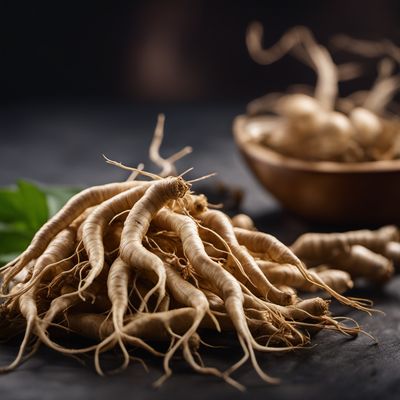
Ingredient
Siberian ginseng infusion roots
"The Energizing Elixir: Unleashing the Power of Siberian Ginseng Infusion Roots"
Siberian Ginseng Infusion Roots, scientifically known as Eleutherococcus senticosus, are slender, woody roots that boast a distinctively earthy aroma and a slightly bitter taste. These roots are typically dried and used to make infusions or teas, releasing a golden hue and a rejuvenating flavor. With a fibrous texture and a gnarled appearance, Siberian Ginseng Infusion Roots are revered for their adaptogenic properties and are believed to enhance vitality and promote overall well-being.
Origins and history
Native to the forests of Siberia, Russia, Siberian Ginseng Infusion Roots have a rich historical background deeply rooted in traditional Chinese and Russian medicine. For centuries, these roots have been used to combat fatigue, improve mental clarity, and boost the immune system. They were traditionally consumed as a tonic to increase stamina and endurance, particularly during harsh winters. Today, Siberian Ginseng Infusion Roots are cultivated in various regions worldwide, including China, Korea, and Japan.
Nutritional information
Siberian Ginseng Infusion Roots are a nutrient-dense ingredient, rich in antioxidants, vitamins, and minerals. They are particularly high in eleutherosides, compounds known for their adaptogenic properties. Additionally, these roots are low in calories and fat.
Allergens
Siberian Ginseng Infusion Roots are generally considered safe for consumption and are not commonly associated with allergens. However, individuals with known allergies to plants in the Araliaceae family should exercise caution.
How to select
When selecting Siberian Ginseng Infusion Roots, look for roots that are firm, dry, and free from mold or signs of decay. Choose roots that are relatively straight and have a uniform color. Avoid roots that appear shriveled or have a strong, unpleasant odor.
Storage recommendations
To maintain the freshness and quality of Siberian Ginseng Infusion Roots, store them in a cool, dry place, away from direct sunlight. It is advisable to keep them in an airtight container to prevent moisture absorption. Properly stored, these roots can retain their potency for up to a year.
How to produce
Siberian Ginseng Infusion Roots can be challenging to grow for amateurs due to their specific environmental requirements. They thrive in cool, temperate climates with well-drained soil and partial shade. Propagation can be done through seeds or root cuttings, but it is recommended to seek guidance from experienced growers or nurseries.
Preparation tips
To prepare a Siberian Ginseng infusion, steep 1-2 teaspoons of dried roots in hot water for 5-10 minutes. Adjust the steeping time according to personal preference for a stronger or milder flavor. The infusion can be enjoyed on its own or combined with other herbs or teas. Siberian Ginseng Infusion Roots can also be used in soups, stews, or as a flavoring agent in various dishes.
Culinary uses
Siberian Ginseng Infusion Roots are primarily used to make invigorating infusions or teas. They can also be incorporated into broths, soups, and herbal blends to add depth and a subtle bitterness. Additionally, these roots can be used as a natural flavoring agent in desserts, sauces, and marinades.
Availability
Siberian Ginseng Infusion Roots are commonly available in health food stores, herbal shops, and online retailers. They are cultivated in regions such as China, Korea, Japan, and Russia.
